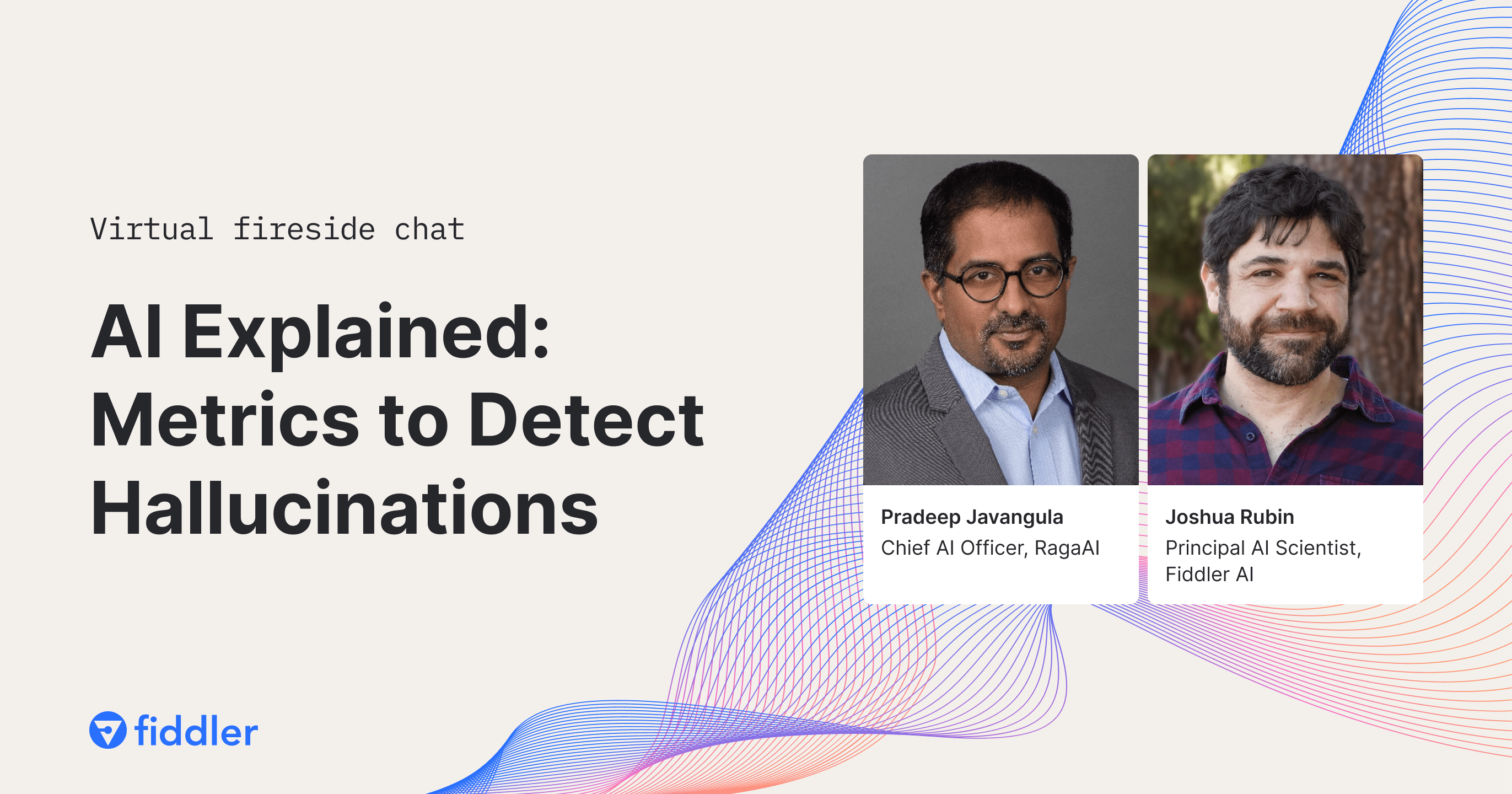Monitoring hallucinations is fundamental to delivering correct, safe, and helpful large language model (LLM) applications. Hallucinations — instances where AI models generate outputs not grounded in factual accuracy — pose significant challenges. In our recent AI Explained fireside chat series, Pradeep Javangula, Chief AI Officer at RagaAI, shared the nuances of hallucinations in LLMs, discussing their definition, the concerns they raise, approaches for monitoring and evaluating them, and how to effectively reduce the risks of hallucinations.
Why Hallucinations Happen in LLMs?
Hallucinations occur when LLMs, which have been trained on extensive text corpora, attempt to predict the next token or sequence of tokens based on the data they have been trained on. These models lack an understanding of truth or the factual accuracy of their outputs. The content generated by these models is based on statistical likelihoods rather than factual correctness. This means that while the AI might produce text that is statistically plausible within the context of its training data, it does not have the capability to discern or ensure truthfulness.
Because the model operates purely on statistical prediction without awareness of truth, the outputs may sometimes appear to "make stuff up." This can result in outputs that are not only inaccurate but also potentially misleading or harmful if taken at face value. As a result, there are significant risks associated with AI hallucinations, especially when such outputs are used in critical applications. The LLM's inability to distinguish between factual and fabricated content can pose serious implications, making it a top concern for enterprises.
Concerns and Challenges in Hallucinations
Hallucinations in LLMs pose considerable concerns and challenges that deter enterprises from widely adopting and implementing the use of LLM applications. Key challenges include:
- Safety: One of the primary concerns with hallucinations in AI, particularly in critical applications, is the safety risk they pose. Inaccurate or misleading information can lead to decisions that jeopardize user safety, such as incorrect medical advice or faulty navigation instructions.
- Trust: Hallucinations can significantly erode trust in AI systems. Users rely on AI for accurate and trustworthy information, and frequent inaccuracies can lead to distrust, reducing the adoption and effectiveness of AI technologies across various sectors.
- Implementation Challenges: Detecting and mitigating hallucinations pose significant implementation challenges. LLMs are complex and require sophisticated techniques to monitor and correct hallucinations effectively. This complexity can hinder the deployment of reliable LLM applications.
- Regulatory and Ethical Issues: There are regulatory and ethical implications to consider. As LLM applications are more widely adopted, they must comply with increasing regulatory standards that govern data accuracy and user safety. Ensuring that LLM applications do not hallucinate misleading information becomes not only a technical challenge but also legal and ethical risks.
- Resource Intensity: Monitoring and mitigating hallucinations require significant computational resources and expertise. The need for ongoing evaluation and updates to AI models to address hallucinations can be resource-intensive, impacting the scalability and sustainability of LLM projects.
- Barrier to Widespread Adoption: Persistent issues with hallucinations can act as a barrier to the wider adoption of AI technologies. If enterprises and consumers perceive AI as risky due to unaddressed hallucinations, this perception can slow down the integration of AI into everyday applications.
The Importance of Evaluating and Monitoring LLMs
Monitoring and evaluating LLM responses for hallucinations is essential for maintaining model performance. Key metrics to monitor include:
- Perplexity: A measure of how well the probability distribution predicted by the model matches the observed outcomes; higher perplexity may indicate more frequent hallucinations.
- Semantic Coherence: Evaluating whether the text is logically consistent and stays relevant throughout the discourse.
- Semantic Similarity: Determine how closely the language model's responses align with the context of the prompt. This metric is useful for understanding whether the LLM is maintaining thematic consistency with the provided information.
- Answer/Context Relevance: The importance of ensuring that the model not only generates factual and coherent responses but also that these responses are contextually appropriate to the user's initial query. This involves evaluating whether the AI’s output is directly answering the question asked or merely providing related but ultimately irrelevant information.
- Reference Corpus Comparison: Analyzing the overlap between AI-generated text and a trusted corpus helps identify deviations that could signal hallucinations.
- Monitoring Changes: Monitoring how well the LLM adapts to changes in the context or environment it operates in is also important. For instance, if new topics or concerns arise that were not part of the original training data, the LLM might struggle to provide relevant answers. Prompt injection attacks or unexpected user interactions can reveal these limitations.
- Prompt and Response Alignment: Both the retrieval mechanism (how information is pulled from the database or corpus) and the generative model (how the response is crafted) must work harmoniously to ensure that responses are not only accurate but also relevant to the specific context of the query.
Reducing Risks Associated with Hallucinations
Key practices for reducing hallucinations and improving the correctness and safety of LLM applications include:
- Observability: Implementing a comprehensive AI observability solution for LLMOps is critical to ensuring LLM performance, correctness, safety, and privacy. This allows for better monitoring of LLM metrics, and enables quicker issue identification and resolution related to hallucinations.
- Evaluation and Testing: Rigorous LLM evaluation and testing prior to deployment are vital. Evaluating models thoroughly during the pre-deployment phase helps in identifying and addressing potential hallucinations, ensuring that the models are trustworthy in production.
- Feedback Loops: Utilizing feedback loops is an effective approach for mitigating hallucinations. LLM applications can be improved by analyzing production prompts and responses.
- Guardrails: Implementing strict operational boundaries and constraints on LLMs helps prevent the generation of inappropriate or irrelevant content. By clearly defining the limits of what the AI can generate, developers can greatly decrease the occurrence of hallucinated outputs, ensuring that the responses are safe, correct, and ensure alignment with human values/expectations.
- Human Oversight: Including human reviewers in the process, particularly for critical applications, can provide an additional layer of scrutiny that helps catch and correct errors before they affect users.
- Fine-Tuning: Adjusting model parameters or retraining models with additional data that specifically targets identified weaknesses can improve the models' accuracy and reduce the chances of hallucination. This approach helps align the model outputs more closely with reality, addressing any gaps or hallucinations that were initially present.
While LLMs offer significant opportunities to generate new revenue streams, enhance customer experiences, and streamline processes, they also present risks that could harm both enterprises and end-users. Rigorous testing and evaluation before LLM deployment, establishing clear operational boundaries, and incorporating human oversight are critical to mitigate the risk of LLM hallucinations. Furthermore, continuous monitoring and feedback loops, coupled with strategic fine-tuning, are vital to ensure that LLM applications not only meet but exceed our standards for safety and trustworthiness. As we integrate AI more deeply into various aspects of our lives, it is crucial to remain vigilant and proactive, paving the way for more responsible AI development that benefits all users.
Watch the full AI Explained below:

